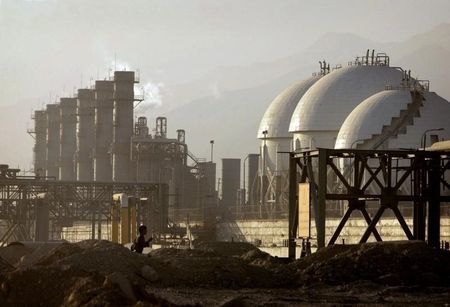Commodities
Oil prices slip; traders await Israel’s response to Iran attack

Investing.com– Oil prices retreated Tuesday, falling from six-month highs on speculation that an response from Israel to an Iranian attack would be measured.
AT 08:45 ET (12:45 GMT), fell 0.3% to $85.14 a barrel, while dropped 0.4% to $89.76 a barrel .
Uncertainty in the Middle East
Geopolitical tensions in the Middle East ramped up over the weekend after Iran launched a large-scale drone and missile strike against Israel.
Speculation of such an attack had driven oil prices to their highest levels since October on Friday, amid fears such a move could lead to all-out war in the Middle East, dragging in countries like the U.S..
Tensions between Iran and Israel have been a key point of support for oil prices, as traders bet that a widespread conflict in the Middle East will disrupt supply from the oil-rich region.
Iran in particular is a member of the Organization of Petroleum Exporting Countries, and is a key producer in the Middle East.
However, prices fell on Monday, and have continued to drift lower, after Iran’s attack on Israel proved to be less damaging than anticipated, easing concerns of a quickly intensifying conflict that could disrupt supply.
“The key for markets will now be the extent of the retaliation. Should Israel follow up with similarly ambitious missile attacks or, under a worse-case scenario, other nations become embroiled in the conflict, notably the US, then we would likely see a flight to safety in markets, whereby investors flock to the safe-havens at the expense of high-risk assets,according to Matthew Ryan, Head of Market Strategy at global financial services firm Ebury.
“The threat to global oil supply would also likely trigger a sharp move upwards in oil prices, which could comfortably jump above $100 a barrel should investors fear a wider regional war.”
Additionally, the Iran’s attack on Israel is unlikely to prompt dramatic sanctions action on the Persian country’s oil exports from the Biden administration due to worries about boosting oil prices and angering top buyer China.
The political pressure to punish Iran creates a thorny problem for the Biden administration: how to deter such attacks in future without escalating regional tensions, raising oil prices or antagonizing China, the biggest buyer of Iranian oil.
Washington has said for months that among its primary goals is to keep the Gaza conflict between Palestinian group Hamas and Israel from metastasizing in to a wider regional war, with a key aim of keeping Tehran on the sidelines.
Chinese growth offers limited support
Beyond the tensions in the Middle East, the crude markets received tentative support from stronger-than-expected first-quarter data from China.
Data released earlier Tuesday showed that Chinese rose 5.3% year-on-year in the first three months of the year, above expectations of 4.8% growth and improved from the 5.2% print seen in the prior quarter.
However, the news was mixed as other data released around the same time, i.e. and , painted a weaker picture, as the world’s second-largest economy has struggled to mount a strong and sustainable post-COVID bounce, burdened, in particular, by a protracted property downturn.
Data on inventories, from the , later in the session will be studied carefully, after last week’s data from the industry body showed that crude stockpiles rose more than expected.
(Ambar Warrick contributed to this article.)
Commodities
Oil edges higher as investors eye Mideast talks, rates meeting

By Noah Browning and Deep Kaushik Vakil
LONDON (Reuters) – Oil edged up on Tuesday a day after falling as Israel-Hamas talks offered hopes of a ceasefire even as Red Sea attacks continued, while investors awaited signals on U.S. interest rates ahead of a meeting on Wednesday.
futures for June, which expire on Tuesday, were up 26 cents, or 0.3%, to $88.67 a barrel at 1101 GMT. The more active July contract rose 38 cents, or 0.4%, to $87.58 per barrel.
U.S. West Texas Intermediate crude futures were up 34 cents, or 0.4%, to $82.97 a barrel. The front-month contract of both benchmarks lost more than 1% on Monday.
“New hopes of a ceasefire between Israel and Hamas caused oil prices to fall at the start of the week,” said Commerzbank (ETR:) analyst Carsten Fritsch, adding that prices were also pressured by lower crude demand from refineries leading to higher inventory levels.
Hamas negotiators left Cairo late on Monday to consult with the group’s leadership after talks with Qatari and Egyptian mediators on a response to a phased truce proposal that Israel presented over the weekend.
The delegation was expected to report back within two days, two Egyptian security sources said.
Continued attacks by Yemen’s Houthis on maritime traffic south of the Suez Canal – an important trading route – have provided a floor for oil prices and could prompt higher risk premiums if players anticipate crude supply disruptions.
“The upcoming Fed meeting also drives some near-term reservations,” said Yeap Jun Rong, market strategist at IG. “Rates being kept at elevated levels for longer could trigger a further rise in the U.S. dollar, while also putting some risks to oil demand outlook.”
remove ads
.
Investors are on watch this week for the U.S. Federal Reserve’s May 1 policy review, with stubborn inflation pushing out market expectations for any rate cuts, which could bolster the U.S. dollar and hamper oil demand.
Some investors are cautiously pricing a higher probability that the Fed could hike interest rates by a quarter percentage point this year and next as inflation and the labour market remain resilient.
Additionally, concerns over demand have weighed on sentiment, ANZ analysts said in a research note, as premiums for diesel and over have fallen to their lowest in months.
Commodities
Oil prices rise; Israel/Hamas peace talks, Fed meeting in focus

Investing.com– Oil prices edged higher Tuesday, rebounding after the prior session’s declines with the focus remaining on the ceasefire talks between Israel and Hamas and the latest Federal Reserve meeting.
At 08:50 ET (12:50 GMT), rose 0.6% to $87.71 a barrel, while gained 0.7% to $83.23 a barrel.
Israel-Hamas ceasefire talks in focus
Both benchmarks had fallen around 1% on Monday after delegates from Israel and the militant group Hamas met in Cairo for peace talks.
Media reports said that Israel had offered a 40-day ceasefire offer to Hamas in exchange for the return of hostages and displaced families begin allowed back into northern Gaza. It also includes new wording intended to satisfy Hamas’ need for a permanent ceasefire.
The Hamas delegation left Cairo, and will return with a written response to the proposal, reports said.
Peace talks between Israel and Hamas have repeatedly fallen through in recent months, with Hamas stating that it will not accept any proposal short of a permanent ceasefire.
But a ceasefire represents a potential de-escalation in the conflict, which could see traders attach an even lower risk premium to oil.
Fears of disruptions in Middle East supply have been a key booster of oil prices in recent weeks.
Fed meeting, interest rate policy in focus
Oil prices have also been pressured by the prospect of higher-for-longer U.S. interest rates, ahead of a this week
The central bank is widely expected to keep rates steady. But any signals on future rate cuts will be watched, especially as traders have largely priced out the prospect of early rate cuts in 2024.
remove ads
.
Markets fear that higher-for-longer rates will pressure the global economy and in turn dent oil demand this year.
Strength in the also pressured oil prices.
The is scheduled to release its latest estimate of weekly crude inventories later in the session.
G7 agrees to end coal use in power generation
In other news, energy ministers from the Group of Seven major democracies agreed on Tuesday to end the use of coal in power generation “during the first half of (the) 2030s”, according to an official communique.
However, in a caveat, the statement included an alternative goal of phasing out coal-fired power plants “in a timeline consistent with keeping a limit of a 1.5°C temperature rise within reach, in line with countries’ net-zero pathways”.
(Ambar Warrick contributed to this article.)
Commodities
Oil prices slide on Middle East peace talks; Fed decision awaited

Investing.com–Oil prices drifted lower Monday as peace talks between Israel and militant group Hamas in Cairo tempered fears of a wider conflict in the Middle East disrupting supplies, but losses were limited by caution ahead of the latest Federal Reserve meeting.
At 08:25 ET (12:25 GMT), fell 0.6% to $87.69 a barrel, while fell 0.7% to $83.25 a barrel.
Middle East peace talks
A Hamas delegation will visit Cairo on Monday for talks aimed at securing a ceasefire, a Hamas official told Reuters on Sunday, with the group expected to respond to Israel’s latest Gaza phased truce proposal delivered on Saturday.
Concerns that the conflict between Hamas and Israel would balloon into a wider war in the oil-rich region prompted sharp gains earlier this month, as traders worried that this could result in a big hit to supplies from the region.
US rate fears grow on sticky inflation, Fed anticipation
Markets further dialed back bets on early interest rate cuts by the Federal Reserve after data- the Fed’s preferred inflation gauge- read hotter than expected for March.
Fears of higher-for-longer U.S. interest rates factored into concerns that oil demand will weaken later this year, especially as economic growth weakens. This notion was furthered by weaker-than-expected U.S. growth data last week.
Strength in the , following the inflation data, also pressured crude prices.
The focus is now squarely on a meeting later this week, where the central bank is widely expected to keep rates steady and offer hawkish signals on monetary policy.
remove ads
.
Beyond the Fed, more economic cues were also in focus this week for oil markets. data from top importer China is due later in the week, and is expected to offer more insight into an ongoing economic recovery in the country.
Geopolitical tensions, tight supply bets persist
The specter of geopolitical tensions and potential supply risks in oil markets still remained in play.
Ukraine attacked more Russian oil refineries over the weekend, while also calling on more military aid from the U.S. over worsening conditions on the front lines.
Attacks on Russian refineries factored into bets on tighter supplies, especially as Russia announced more production and export cuts earlier this year.
(Ambar Warrick contributed to this article.)

 Forex2 years ago
Forex2 years agoForex Today: the dollar is gaining strength amid gloomy sentiment at the start of the Fed’s week

 Forex2 years ago
Forex2 years agoHow is the Australian dollar doing today?

 Forex1 year ago
Forex1 year agoUnbiased review of Pocket Option broker

 Forex2 years ago
Forex2 years agoDollar to pound sterling exchange rate today: Pound plummeted to its lowest since 1985

 Cryptocurrency2 years ago
Cryptocurrency2 years agoWhat happened in the crypto market – current events today

 World2 years ago
World2 years agoWhy are modern video games an art form?

 Stock Markets2 years ago
Stock Markets2 years agoMorgan Stanley: bear market rally to continue

 Economy2 years ago
Economy2 years agoCrude oil tankers double in price due to EU anti-Russian sanctions

































